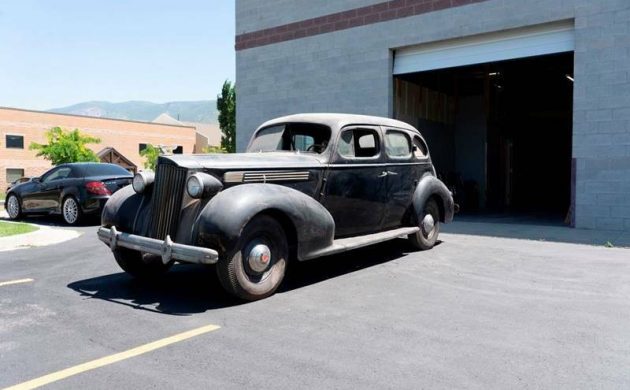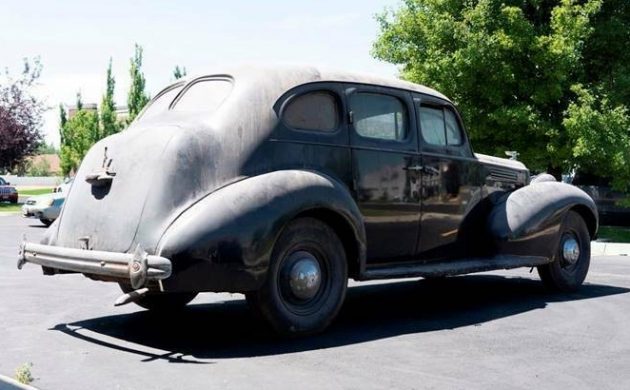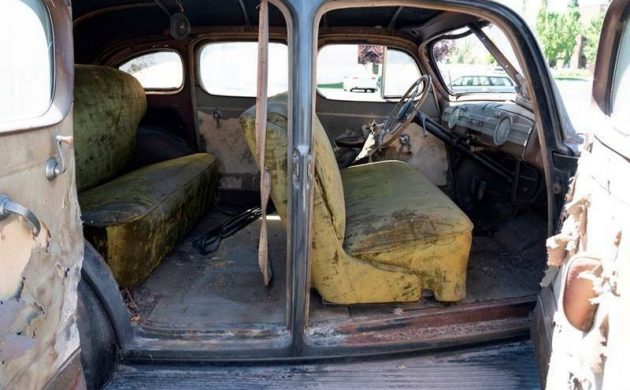Into the 1930s, Packard remained America’s most successful luxury car brand. However, unlike Cadillac and Lincoln which had parent companies that were capable of absorbing any potential financial losses, Packard was fully independent. This led the company to introduce what was referred to as its “junior” models, which included the Packard 120. This was Packard’s attempt to produce a more affordable vehicle during the Great Depression, and it virtually guaranteed that Packard would remain a profitable manufacturer into the immediate future. This 1939 Packard 120, from the 2nd Series of that model, has been in the same family for 50-years. They have decided to part with it, so this is the chance for someone to secure for themselves a fairly solid project car. You will find the 120 located in Farmington, Utah, and listed for sale here on eBay. The owner has set the BIN on the 120 at $7,990.
The 120 looks like a big, heavy car, but it is one that deceives. With a wheelbase of 10.5′ and a total weight of 3,800lbs, it is smaller and lighter than it would appear to be in the photos. After 50-years of ownership, the car is now going to need a fair amount of restoration work to make it perfect once again. However, getting the body and paint up to a Packard-like level doesn’t look like it is going to be a huge job. The car is said to be solid, and the only real rust of note appears to be around the inner rear fenders. Given that these are easily accessible, rectifying this should be a relatively straightforward job. There are a few minor dings on the car, but even these don’t look to be too bad. Potentially the biggest bug-bear for the next owner will be locating some of the replacement glass that will be required. This includes the driver’s side windshield and the glass in the driver’s door. It’s a bit hard to be sure, but while it appears that all of the external chrome and trim is present, some of it may need restoration.
Restoration work on the interior will definitely be on the cards. The upholstery on the seats isn’t original, and nor is it particularly nice. Every upholstered surface will need restoration, but the dash appears to be complete, and in quite good condition. It’s when you look at the interior of the 120 that you realize that for a car that hails from a conservative, luxury car manufacturer, the Packard is actually a pretty clever piece of design. With the front wheels pushed as far forward as possible, that leaves the entire length of the engine behind the front axle centerline. That is not a short engine, and the remaining space for the passenger compartment fits between the rear of the engine and the rear axle centerline. Yet, you look at the rear-seat legroom, and there’s nearly enough space back there to host a dance party. Adding to the practicality of the 120, Packard had introduced a column shifter, which now meant that it was possible to seat three people across the front seat. To me, this ability to utilize the available space so effectively helps to explain why Packard was so successful as a luxury manufacturer.
Powering the 120 is a 282ci straight-eight engine. This flathead engine produced 120hp, and as was so often the case with engines from this company, it was a remarkably quiet and refined engine for that particular time. The power from this engine is then sent to the rear wheels via a 3-speed manual transmission. The Packard doesn’t currently run, but the engine is said to turn freely. The owner has soaked the cylinders and turned the motor by hand, so it will be the next owner’s decision as to whether they attempt to fire the Packard back into life, or whether they choose to give it a thorough check, and possibly a rebuild.
Packard developed and released the 120 model in an ultimately successful bid to cement its future during a time of great financial uncertainty. In 1939, Packard managed to sell a total of 24,350 cars across its entire range. Of these cars, 17,647 were the 120, similar to this car. That the brand should be so strong in 1939 and should bow out of the market with barely a whimper only two decades later is amazing to consider. It is possible today to buy a fairly clean 120 for under $20,000, but a pristine example will set you back closer to $35,000. This one looks like it is a solid project car, and in reality, the majority of its need could be attended to in a home workshop. With Winter on the way, maybe this would make a great project to occupy the colder months.







This would make a luxurious street rod, and glass wouldn’t be a problem for this car as it’s all flat.
Another vote to destroy a great old car. Sad, just sad.
Another purist who can’t handle it when someone has a different opinion on what to do with a car. Sad, just sad. How many thumbs up did you get on your comment?
Being an engineer by training I tend to stay with the original designs. Like to see how problems were solved back then. Can also enjoy seeing a car customized to suit one person’s tastes.
Back in December was diagnosed with cancer. They tell me that the average person with this lives about five years. The longest living was eight years. Got two kids that I will not get to know as adults.
Helps me realize that no matter how much I enjoy cars there are more important things to argue about than how someone else is going to treat an inanimate object.
Visited a local car meet. A gentlemen with a 120 sedan like this let both my kids get in and explore. My 10 year old son has set a Packard 120 coupe as his dream car. One day we saw one and he fell in love. The man saw him starring and pointing so he parked next to our Toyota Highlander and started chatting. Was surprising how the Highlander was longer and wider than the Packard.
Can see how this one would be tempting to modify. Would be a shame to lose that wonderfully smooth motor.
SMS…I’m truly saddened to read in your other comment about your diagnosis. Fight Fight FIGHT the big C! I’m no bible thumper or anything, but, you’ll be in my prayers. Can’t hurt right?
Thanks Mike,
Found out to my surprise that there are some cancers you can beat and others you can only treat.
Focusing on what I have and not what i’ve lost.
Pretty cool, but an ambitious restoration, the 120 was a great idea at the time. This Kantner in NJ has everything you’d need mechanical, body or interior parts are going to be tough. With the state of the old car hobby, these come through auctions and are a hard sell, even in nice condition, they barely crack $10g’s. With no bids, I really don’t see someone taking this on today.
True, the old car hobby ain’t what it usta be, eh? Now I record all of the big auto auctions so I can fast forward thru all the Corvettes, Novas. T-birds and pickups and stop when I see something that really is interesting!! When BJ started years ago it was mostly all old classics. Whoever takes on this grand old lady, it will have to be a strong case of pure love of the car. A resto of this Packard will not be an investment except in the pure enjoyment of the automobile. Now…..where did I put that remote control?
Just get it up to driver status and drive it while you restore it. That’s what a lot
of us motorheads did 50 years ago. Of course, we were encouraged to do this
by the staff at Rod & Custom Magazine with tons of how-to articles that covered
everything from engine repairs to electrical wiring and so much more. It certainly
didn’t hurt to see what other guys around the country were working on either. As
a kid, I just couldn’t wait to see Rods And Customs At Random just to see all the
really cool cars that appeared on those pages. Why, I even saw a Packard hearse
with a 392 hemi in it! Would be nice to see this car being done old school–driven
while being restored.
Something like this I wouldn’t mind being restomoded. One of neatest cars I almost bought and really wish I had was a ’39 Chevy 4 door done up with deep maroon paint and a 2 tone grey interior that was really slick. 454 with automatic, updated running gear, a/c, wide painted wheels with small caps, and yes… lowered just enough to keep this low rider happy. Box stock exterior with those great teardrop taillights. 1989, big car show, $13K and I didn’t buy it.
You sit over the rear axle in cars of that era . Sure there is a lot of rear legroom but the ride is less comfortable than riding ahead of the rear axle
Actually, if you look at the side view of this, it’s fairly apparent that the back seat is ahead of the rear axle … and the article did mention that the wheelbase was stretched out so that both engine and passenger compartment were set within the wheelbase. This not only allows for a lower roofline, it helps both ride and handling (as Citroen discovered at around this time as well).
My own favorite Packards, appearance-wise, are the separate-fender 1941 models (that is, not including the balloony Clippers). Part of that is that I’m a 1941 model myself, but there is something about the balance of proportion and trim, and the fact that it was the last year for the older design. I think this ’39 would be much better-looking with just a freshening of the finish, or maybe with a brighter color. It’s not exactly ugly as it sits, though.
A late connection of mine’s Father bought a 1938 Packard 110/120 sedan (can’t remember which) in 1947, and loaded up the wife and three sons with much luggage and proceeded to drive it overland to South Africa. By the time they arrived in Southern Rhodesia (Zimbabwe) the only breakdowns had been a broken rear spring and a puncture. They were approached by a bunch of university guys, who upon hearing their story, promptly bought the car from the father and drove it back to UK. The family then settled in SR until Mugabe arrived so moved on to South Africa where I met my connection.
Just put a t5 or tremec and some late model leather car interior and enjoy the straight 8 and the ride.
I am one of those who would hate to see it hot rodded but to each his/her own. I’d love to restore it to it’s original and driven daily while doing it.
I love the Goddess of Speed, or Lady Chasing a Donut, hood ornament maybe more than the cormorant.
It was the original, I’m pretty sure. I don’t remember the cormorant on any pre-war cars, though I have been wrong once or twice before. There is something so literal-minded about the Goddess, a divine being devoted to fast travel. No fancy-dandy bird that could have no idea what it was stuck onto a car for.
Now, for sheer car porn, let’s consider the kid in flowing about-to-be-blown-off robes, with the very unambiguous name: The Spirit of Ecstasy. Whoopee! She’s not just along for the ride, she’s getting off on it. So much for Rolls-Royce’s “staid” image!
There was one in my neighborhood, often parked in front of our house, during the day, in the early 1950’s, owned by a guy who worked in one of the local stores. I thought the humpback rear was ugly then, and I still think so now. He had to hand crank it to start it, and had chocks under the wheels so it would not roll down the very modest hill we lived on then, guess he trusted the parking brake enough to hold it while he took the chocks out, my mother told me NOT to do it for him, no matter what he offered, usually 10 cents, the price of a Superman comic book, since it might just might roll back and run me over. Ugly then, ugly now – basically, to me, the Fords from the era all looked pretty good, but the Chrysler and GM products were pretty ugly between 1935 and l940.
Note to prospective buyer. Please don’t rod it. Reserve rodding for incomplete rusted out basket cases. This car is far to beautiful, complete and solid to rod. If we keep rodding cars like this, future generations will have nothing left to restore. Rant over,
Pretty solid outside but a mess inside.
Cannot see anyone restoring it.
Cars of this vintage don’t draw attention anymore except from hobbyists.
Saw a similar one at auction and it had a full sheet of instuctions on how to start it and drive it. It was a driver but never reached the reserve.
Even though I feel every day of my nearly 51 years, I’m not old enough to remember these cars new. However, even though I’ve never owned one, I’ve always had a soft spot for the “full classics”. I have very old pictures of my grandpa standing next to his Stutz Bearcat as well as a Packard (don’t know what model) that he also owned. Personally, I restore GM “square body” pickups, as well as the Dodge and Ford trucks from the same era, in my spare time. If I had the time, money, and, most important, skills, I’d LOVE to take on a car like this! The future owner can do what they want, but, if it was mine, I’d put it back to pure stock, maybe upgrade the brakes if possible. My lottery winning, money is not an object car is a Murphy bodied Duesenburg model J (preferably SJ but I’ll take the non supercharged one lol!) dual cowl phaeton.